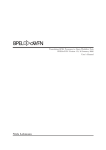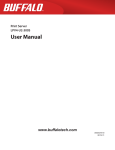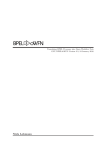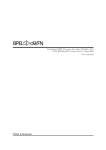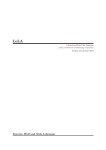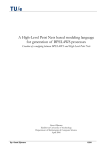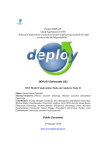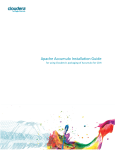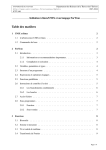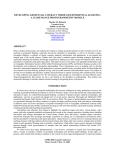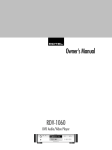Download Installation Manual
Transcript
Translating BPEL Processes into Open Workflow Nets GNU BPEL2oWFN Version 2.0.2, 15 June 2007 Installation Manual Niels Lohmann About this document: This manual describes the installation of GNU BPEL2oWFN, version 2.0.2, a tool translating a web service described in BPEL into open workflow net (oWFN), last updated 15 June 2007. Copyright c 2005, 2006, 2007 Niels Lohmann Permission is granted to copy, distribute and/or modify this document under the terms of the GNU Free Documentation License, Version 1.2 or any later version published by the Free Software Foundation; with no Invariant Sections, with the Front-Cover Texts being “A GNU Manual,” and with the Back-Cover Texts as in (a) below. A copy of the license is included in the section entitled “GNU Free Documentation License.” (a) The FSF’s Back-Cover Text is: “You have freedom to copy and modify this GNU Manual, like GNU software.” Once GNU BPEL2oWFN is installed please read the User’s Manual which is part of the distribution or can be downloaded from the website of GNU BPEL2oWFN, http://www.gnu.org/software/bpel2owfn. GNU BPEL2oWFN was developed during the Tools4BPEL project funded by the German Federal Ministry for Education and Research (BMBF), see http://www.informatik.hu-berlin.de/top/tools4bpel for details. i Table of Contents 1 Contents of this Distribution . . . . . . . . . . . . . . . . . . . . . . . . . . . . . . . . . 1 1.1 1.2 2 Setup and Installation . . . . . . . . . . . . . . . . . . . . . . . . . . . . . . . . . . . . . . . . . 2 2.1 2.2 2.3 2.4 3 Setup . . . . . . . . . . . . . . . . . . . . . . . . . . . . . . . . . . . . . . . . . . . . . . . . . . . . . . . . . . . . . . . . . . . . . . . . . . . . . Installation . . . . . . . . . . . . . . . . . . . . . . . . . . . . . . . . . . . . . . . . . . . . . . . . . . . . . . . . . . . . . . . . . . . . . . . . Problems during Setup or Installation. . . . . . . . . . . . . . . . . . . . . . . . . . . . . . . . . . . . . . . . . . . . . . Makefile Targets . . . . . . . . . . . . . . . . . . . . . . . . . . . . . . . . . . . . . . . . . . . . . . . . . . . . . . . . . . . . . . . . . . . Required Programs . . . . . . . . . . . . . . . . . . . . . . . . . . . . . . . . . . . . . . . . . . . . . . . . . . . . . . . . . . . . . . . . Optional Programs . . . . . . . . . . . . . . . . . . . . . . . . . . . . . . . . . . . . . . . . . . . . . . . . . . . . . . . . . . . . . . . . Supported Platforms . . . . . . . . . . . . . . . . . . . . . . . . . . . . . . . . . . . . . . . . . . . . . . . . . . . . . . . . . . . . . . Reference System . . . . . . . . . . . . . . . . . . . . . . . . . . . . . . . . . . . . . . . . . . . . . . . . . . . . . . . . . . . . . . . . . . 6 6 6 7 Change Log . . . . . . . . . . . . . . . . . . . . . . . . . . . . . . . . . . . . . . . . . . . . . . . . . . . . 8 Version Version Version Version Version Version 5 2 3 4 4 Tool Dependencies. . . . . . . . . . . . . . . . . . . . . . . . . . . . . . . . . . . . . . . . . . . . . 6 3.1 3.2 3.3 3.4 4 Files . . . . . . . . . . . . . . . . . . . . . . . . . . . . . . . . . . . . . . . . . . . . . . . . . . . . . . . . . . . . . . . . . . . . . . . . . . . . . . 1 Directories . . . . . . . . . . . . . . . . . . . . . . . . . . . . . . . . . . . . . . . . . . . . . . . . . . . . . . . . . . . . . . . . . . . . . . . . 1 1.0 (16 January 2006) . . . . . . . . . . . . . . . . . . . . . . . . . . . . . . . . . . . . . . . . . . . . . . . . . . . . . . . 8 1.1 (24 February 2006). . . . . . . . . . . . . . . . . . . . . . . . . . . . . . . . . . . . . . . . . . . . . . . . . . . . . . . 8 1.2 (6 April 2006) . . . . . . . . . . . . . . . . . . . . . . . . . . . . . . . . . . . . . . . . . . . . . . . . . . . . . . . . . . . 8 2.0.0 (20 April 2007). . . . . . . . . . . . . . . . . . . . . . . . . . . . . . . . . . . . . . . . . . . . . . . . . . . . . . . . . 9 2.0.1 (11 May 2007) . . . . . . . . . . . . . . . . . . . . . . . . . . . . . . . . . . . . . . . . . . . . . . . . . . . . . . . . . 9 2.0.2 (15 June 2007) . . . . . . . . . . . . . . . . . . . . . . . . . . . . . . . . . . . . . . . . . . . . . . . . . . . . . . . . 10 Authors and Acknowledgements . . . . . . . . . . . . . . . . . . . . . . . . . . . . 11 5.1 5.2 5.3 Authors . . . . . . . . . . . . . . . . . . . . . . . . . . . . . . . . . . . . . . . . . . . . . . . . . . . . . . . . . . . . . . . . . . . . . . . . . . 11 Acknowledgements . . . . . . . . . . . . . . . . . . . . . . . . . . . . . . . . . . . . . . . . . . . . . . . . . . . . . . . . . . . . . . . 11 Contact Person . . . . . . . . . . . . . . . . . . . . . . . . . . . . . . . . . . . . . . . . . . . . . . . . . . . . . . . . . . . . . . . . . . . 12 Appendix A GNU Free Documentation License . . . . . . . . . . . . . 13 Chapter 1: Contents of this Distribution 1 1 Contents of this Distribution 1.1 Files AUTHORS A list of the authors of BPEL2oWFN, acknowledgements, and a contact address. ChangeLog The change log listing all changes made during the distribution versions of BPEL2oWFN. COPYING The GNU General Public License (GPL) under which BPEL2oWFN is distributed. INSTALL Setup and Installation instructions and all information needed to bootstrap BPEL2oWFN. NEWS News concerning the most recent version of BPEL2oWFN. README A file describing the contents of the distribution. Moreover, the distribution’s root directory contains several files controlling the setup, build and installation process. These files were generated by the GNU Autotools. For more information on the installation process see Chapter 2 [Setup and Installation], page 2. 1.2 Directories 1 src The sources of BPEL2oWFN. The current development sources can be access via anonymous CVS, see https://savannah.gnu.org/cvs/?group=bpel2owfn for more information. Each file contains a short documentation of what it does as well as Doxygen-styled comments (see http://www.stack.nl/~dimitri/doxygen for details).1 doc The documentation of BPEL2oWFN consisting of a manual and this installation manual. The documentation is in Texinfo format and can be converted into many file formats using ‘make format ’ where ‘format ’ is a file format out of ‘dvi’, ‘html’, ‘pdf’ or ‘ps’. tests Several test processes to self-test BPEL2oWFN. The sub-directory ‘tesfiles’ contains the example processes of the WS-BPEL 2.0 and the BPEL4WS 1.2 specification, respectively. The sub-directory ‘sa_tests’ contains, for each supported static analysis goal, a test file that triggers the respective static analysis error message. Finally, sub-directoris ‘consistency’ and ‘bpel4chor’ contain processes to check the ‘choreography’ mode. The tests can be triggered with ‘make check’. A daily updated version of the code documentation can be accessed at http://www.informatik.hu-berlin.de/top/tools4bpel/bpel2owfn/documentation/doxygen. Chapter 2: Setup and Installation 2 2 Setup and Installation The distribution environment of BPEL2oWFN was created using the GNU Autotools. If you are familiar with the setup and installation procedure of any GNU tool you may skip this section. 2.1 Setup To setup the installation environment and to compile BPEL2oWFN simply follow these steps: 1. Unpack the source tarball by entering1 gunzip bpel2owfn-2.0.2.tar.gz tar xf bpel2owfn-2.0.2.tar 2. Enter that directory: cd bpel2owfn-2.0.2 3. Run the configure shell script which attempts to guess correct values for various systemdependent variables used during compilation. It uses those values to create a ‘Makefile’ in each directory of the package. Entering ./configure should lead to an output like: checking checking checking checking checking checking checking checking checking checking checking checking checking checking checking checking checking checking checking checking checking checking checking checking checking checking checking checking checking checking checking checking 1 for a BSD-compatible install... /usr/bin/install -c whether build environment is sane... yes for a thread-safe mkdir -p... /usr/bin/mkdir -p for gawk... gawk whether make sets $(MAKE)... yes build system type... i686-pc-cygwin for g++... g++ for C++ compiler default output file name... a.exe whether the C++ compiler works... yes whether we are cross compiling... no for suffix of executables... .exe for suffix of object files... o whether we are using the GNU C++ compiler... yes whether g++ accepts -g... yes for style of include used by make... GNU dependency style of g++... gcc3 for gcc... gcc whether we are using the GNU C compiler... yes whether gcc accepts -g... yes for gcc option to accept ISO C89... none needed dependency style of gcc... gcc3 how to run the C preprocessor... gcc -E for grep that handles long lines and -e... /usr/bin/grep for egrep... /usr/bin/grep -E for ANSI C header files... yes for sys/types.h... yes for sys/stat.h... yes for stdlib.h... yes for string.h... yes for memory.h... yes for strings.h... yes for inttypes.h... yes Cygwin users should open a tcsh-shell before. Chapter 2: Setup and Installation 3 checking for stdint.h... yes checking for unistd.h... yes checking windows.h usability... yes checking windows.h presence... yes checking for windows.h... yes checking for pow... yes checking whether gcc and cc understand -c and -o together... yes checking for bison... bison -y checking for flex... flex checking lex output file root... lex.yy checking lex library... -lfl checking whether yytext is a pointer... yes checking for kc++... kc++ checking for dot... dot configure: creating ./config.status config.status: creating Makefile config.status: creating doc/Makefile config.status: creating src/Makefile config.status: creating src/Doxyfile config.status: creating tests/Makefile config.status: creating rpm/Makefile config.status: creating rpm/bpel2owfn.spec config.status: creating src/bpel2owfn.h config.status: executing depfiles commands In some cases the configure script complains (i.e. warns) about tools which could not be found in your system path. In this case please check Chapter 3 [Tool Dependencies], page 6. BPEL2oWFN can be compiled without these tools. However, you cannot make changes to large parts of the programm as you will not be able to generate source files without the tools. 4. After all Makefiles are created, run make to compile the executable binary as well as a documentation file. 5. Alternatively, you can run make check to self-test the created binary. After many lines of output2 make check should announce ================== All 6 tests passed ================== or, if anything went wrong, prints error message and requests to report the encountered bug to [email protected]. 2.2 Installation After successful compilation and self tests an executable file ‘bpel2owfn’ (or ‘bpel2owfn.exe’ on systems running Microsoft Windows) is created in the directory ‘bpel2owfn-2.0.2/src’ of the distribution. This file has no dependencies to other files of the distribution and can be copied to any directory. Alternatively you can install BPEL2oWFN properly by executing3 2 3 Unless the test script displays error messages warnings of BPEL2oWFN can be ignored. Usually, ‘make install’ and ‘make uninstall’ can only be executed by the root user. Chapter 2: Setup and Installation 4 make install to copy the binary to the directory ‘/usr/local/bin’ and to make the documentation accessible (i.e. copy it to ‘/usr/local/info’) for info bpel2owfn You can undo the installation by entering make uninstall The setup and installation procedure can be customized by running ./configure with several command-line options. Type ./configure --help for more information. 2.3 Problems during Setup or Installation Any warning during an in other respects successful compilation can be ignored — these warnings mostly occur in generated files from Flex, Bison or Kimwitu++ and are outside of our scope. The compilation of BPEL2oWFN was tested on several operating systems such as Microsoft Windows (running Cygwin), GNU/Linux, Apple Mac OS X and Sun Solaris. Anyway, if the compilation fails please make sure you use the most recent (stable) versions of the GNU Compiler Collection. If this does not help please send us an electronic mail to [email protected]. Include the version number of your distribution (version 2.0.2 of 15 June 2007). Also include in your message the output that the make process produced. We will try to answer your mail within a week. If you are not interested in compiling BPEL2oWFN yourself you can alternatively download executable binaries for several operating systems on the website of BPEL2oWFN (http://www.gnu.org/software/bpel2owfn). 2.4 Makefile Targets The generated Makefiles serve different targets: all Compile BPEL2oWFN and create an executable binary ‘bpel2owfn’ (or ‘bpel2owfn.exe’ on systems running Microsoft Windows) in the directory ‘bpel2owfn-2.0.2/src’. dvi html pdf ps Generate documentation files in the given format which can be DVI, HTML, PDF or PostScript. The documentation is generated in the directory ‘bpel2owfn-2.0.2/doc’ and is named ‘bpel2owfn.format ’ (User’s Manual). clean Clean all temporary files created during the compilation. Executables as well as generated documentation are preserved. Chapter 2: Setup and Installation 5 distclean Clean also source files generated by the compiler generator tools (Flex, Bison and Kimwitu++). Executables as well as created documentation files are also removed. Before re-compilation you have to run ‘./configure’ again. Please note that after running ‘make distclean’ you need the tools described in Chapter 3 [Tool Dependencies], page 6 to compile. check Perform a number of self-tests: the directory ‘tests’ contains several BPEL processes which are read and compiled. Chapter 3: Tool Dependencies 6 3 Tool Dependencies 3.1 Required Programs To compile BPEL2oWFN you do not need any specific program other than the GNU Compiler Collection. If you however want to change the program (e.g. add new Petri net patterns) you need the following programs to generate source code. These programs are (as BPEL2oWFN itself) free software distributed under the GNU General Public License. Flex, A fast scanner generator Flex is needed to generate the lexer of BPEL2oWFN. Flex was written by Vern Paxon. Copyright c 1990 The Regents of the University of California. All rights reserved. Flex is available under http://www.gnu.org/software/flex/flex.html. Bison, The YACC-compatible Parser Generator Bison is needed to generate the parser of BPEL2oWFN. Bison was written by Robert Corbett und Richard Stallman. Copyright c 1992, 1998, 1999, 2003, 2004, 2005 Free Software Foundation, Inc. Bison is available under http://www.gnu.org/software/bison/bison.html. Kimwitu++, The Term Processor Kimwitu++ is needed to generate all files managing the AST (abstract syntax tree). Kimwitu++ was written by Toby Neumann and Michael Piefel. Copyright c 1988-1997 Axel Belinfante, University of Twente. Copyright c 19972007 Michael Piefel, Humboldt-University Berlin. Kimwitu++ is available under http://site.informatik.hu-berlin.de/kimwitu++. 3.2 Optional Programs BPEL2oWFN is a compiler and thus creating output files which can be read by several other programs. These programs are not needed to compile BPEL2oWFN yet without these programs BPEL2oWFN makes not much sense. LoLA, a Low Level Petri net Analyzer LoLA is an explicit model checker implementing a broad variety of reduction techniques such as partial order reduction, symmetries or the sweep line method. LoLA was written by Karsten Schmidt and is available under http://www.informatik.hu-berlin.de/~kschmidt/lola.html. Graphviz, the Graph Visualization Software Graphviz is a graph visualization software with several graph layout programs including dot. Graphviz is maintained by AT&T Labs and is available under http://www.graphviz.org. The Graphviz tool dot can be used to create a graphical representation of the generated Petri net in PNG (Portable Network Graphic) format. If dot is not found on your system, BPEL2oWFN will only create a .dot-file and does not try to invoke dot. 3.3 Supported Platforms BPEL2oWFN is implemented in ANSI C and ANSI C++ and should compile on nearly any platform that supports the GNU Compiler Collection. However, we tested BPEL2oWFN on these platforms: • Microsoft Windows 2000 (x86) • Microsoft Windows XP (x86) Chapter 3: Tool Dependencies • • • • • 7 Microsoft Vista Business (x86) Apple Mac OS X Tiger (PowerPC and x86) Sun Solaris 8 (SPARC) Sun Solaris 9 (SPARC) GNU/Linux (x86) 3.4 Reference System As of June 2007, we use the following system developing and building BPEL2oWFN: • Apple MacBook • 2 GB RAM • Mac OS X 10.4.9 (Tiger) • GNU Compiler Collection 4.0.1 (Apple Computer, Inc. build 5367) • Flex version 2.5.33 • GNU Bison version 2.3 • Kimwitu++ version 2.3.11 The version numbers are not to be understood as system requirements, but as a help if you fail to compile the sources. Chapter 4: Change Log 8 4 Change Log Most recent version at the end of this section. Version 1.0 (16 January 2006) – input: • BPEL process compliant to the specificiation BPEL4WS version 1.1, May 2003. – output: • LoLA Petri net • open workflow net • Dot representation – implemented patterns: • Christian Stahl. A Petri Net Semantics for BPEL. Informatik-Berichte 188, HumboldtUniversität zu Berlin, July 2005. Version 1.1 (24 February 2006) – new output formats: • APNN (Abstract Petri Net Notation) Petri net • PNML (Petri Net Markup Language) Petri net • low-level PEP (Programming Environment based on Petri Nets) Petri net – overworked patterns: • the Stahl-semantics (see version 1.0) has been enhanced and can be parametrized: • original semantics • models without BPEL’s standard faults • acyclic models For more information please refer to the User’s Manual. – static analysis: • To reduce the size of the Petri net model static analysis is used to only generate nodes for the DPE (dead path elimination) when necessary. – miscellaneous: • The compiler generator tools Flex, Bison and Kimwitu++ are not any more necessary to compile BPEL2oWFN: the generated sources are now part of the distrubution. • The oWFN format was overworked and allows final markings. • GNU getopt allows more flexible command-line parameter processing allowing to create several output file formats in a single run. • Debug output can be written into a log file. • The classes organizing the Petri nets are overworked for performance and extensibility. – fixed bugs: • The generation of all possible types of the <invoke> activity (synchronous, asynchronous, with and without implicit scope) is overworked. Version 1.2 (6 April 2006) – overworked patterns: • more parameterized versions of the Stahl-semantics (see version 1.1): • acyclic models (also acyclic event handlers) Chapter 4: Change Log 9 • models without variables • models without standard faults occuring while handling a fault For more information please refer to the User’s Manual. – static analysis: • A control flow graph can be built and used to detect the use of uninitialized variables. – miscellaneous: • The command-line parameter ‘-p finishloop’ is renamed to ‘-p finalloop’. • Structural reduction rules remove all structural dead nodes of the generated Petri net model. – fixed bugs: • Pattern of asynchronous <invoke> activity does no longer receive messages. • Structural reduction rules no longer change the semantics of the <switch> activity. • Structural reduction rules no longer remove the loop transition for deadlock search. Version 2.0.0 (20 April 2007) – input: • executable BPEL4WS 1.1 processes • executable WS-BPEL 2.0 processes • abstract BPEL4WS 1.1 processes (experimental) • abstract WS-BPEL 2.0 processes (experimental) – output: • Petri net file formats: APNN, INA (untimed, low-level), LoLA (low-level), Fiona oWFN, PEP notation (low-level), PNML (with extension to model interfaces), SPIN (Promela) • other file formats: Graphviz dot, XML – implemented patterns: • overworked feature-complete Petri net semantics for BPEL4WS 1.1 and WS-BPEL 2.0 • overworked simplified Petri net semantics to model the communicational behavior only • several versions of each pattern controlled by command-line parameters – static analysis • 44 of 94 static analysis goals of the WS-BPEL specification are checked • read access to uninitialized variables can be detected using the CFG (control flow graph) • conflicting receiving activities can be detected using the CFG – miscellaneous: • completely overworked architecture • all Petri net-related functions are packaged to a Petri net API (application programming interface) to be published independently of BPEL2oWFN soon • statistics of the input process are displayed after implicit transformation rules are applied • messages are classified (error, warning, etc.) and numbered to allow for a detailed description in the manual Version 2.0.1 (11 May 2007) – fixed bugs: • <if>/<switch> pattern did not work with parameter ‘communicationonly’ Chapter 4: Change Log 10 • <flow> activities in repeated constructs (<while>, <repeatUntil>, ...) could result in unbounded nets • parameter ‘xor’ could crash – miscellaneous: • new parameter ‘nointerface’ allows to create dot output of the generated Petri net model without drawing the interface • transitions of the Petri net model are labeled and colored according to their role (only for dot mode) • Petri net reduction rules can be chosen using the ‘reduce’ option • improved performance of composition of nets in the ‘consistency’ mode Version 2.0.2 (15 June 2007) – new features: • BPEL4Chor choreographies can be translated (further information to come) • WSDL files can be parsed to support the translation of a BPEL process • abstract BPEL processes (both BPEL4WS 1.1 and WS-BPEL 2.0) are now parsed – miscellaneous: • when parsing multiple BPEL processes, wildcard like ‘*.bpel’ can be used Chapter 5: Authors and Acknowledgements 11 5 Authors and Acknowledgements 5.1 Authors BPEL2oWFN was written by: • Niels Lohmann, Humboldt-Universität zu Berlin • Christian Gierds, Humboldt-Universität zu Berlin • Martin Znamirowski, Humboldt-Universität zu Berlin 5.2 Acknowledgements We would like to thank: • Sylvain Beucler, GNU Project for his help moving BPEL2oWFN to Savannah, • Maarten Boote, Technische Universiteit Eindhoven for integrating BPEL2oWFN to LaQuSo, • Antoon van Breda a.k.a. Jaded Hobo for the original version of the ‘colorconsole.h’ header, • Jan Bretschneider, Humboldt-Universität zu Berlin for patient C++ help, • Dirk Fahland, Humboldt-Universität zu Berlin for fruitful discussions about BPEL’s semantics, • Carsten Frenkler, Gedilan Technologies for challenging BPEL processes, • Mario Karrenbrock, FH Wilhelmshaven/SAP for finding bugs and testing the consistency mode, • Dieter König, IBM for valuable advice concerning BPEL, • Oliver Kopp, Universität Stuttgart for challenging BPEL processes, • Axel Martens, IBM for valuable advice concerning BPEL, • Harald Meyer, Hasso Plattner Institute for pointing out a bug in the parser, • Simon Moser, IBM for valuable advice concerning BPEL, • Chun Ouyang, Queensland University of Technology for discussion about the Petri net semantics, • Michael Piefel, Humboldt-Universität zu Berlin for help with Kimwitu++, • Dennis Reinert, Humboldt-Universität zu Berlin for his work on the first versions of BPEL2oWFN, • Eric Verbeek, Technische Universiteit Eindhoven for integrating BPEL2oWFN to the ProM framework and valuable comments on BPEL’s link semantics, • Ernesto Santana-Diaz for writing a Java-based GUI for BPEL2oWFN, Chapter 5: Authors and Acknowledgements 12 • Jan Martijn van der Werf, Technische Universiteit Eindhoven for his help with the PNML-oWFN format. BPEL2oWFN is part of the Tools4BPEL project funded by the German Bundesministerium für Bildung und Forschung. 5.3 Contact Person Niels Lohmann Humboldt-Universität zu Berlin Institut für Informatik Unter den Linden 6 10099 Berlin, Germany Homepage E-mail Skype Phone Fax http://www.informatik.hu-berlin.de/top/mitarbeiter/lohmann [email protected] nlohmann (+49) (30) 2093-3070 (+49) (30) 2093-3067 Appendix A: GNU Free Documentation License 13 Appendix A GNU Free Documentation License Version 1.2, November 2002 Copyright c 2000,2001,2002 Free Software Foundation, Inc. 51 Franklin St, Fifth Floor, Boston, MA 02110-1301, USA Everyone is permitted to copy and distribute verbatim copies of this license document, but changing it is not allowed. 0. PREAMBLE The purpose of this License is to make a manual, textbook, or other functional and useful document free in the sense of freedom: to assure everyone the effective freedom to copy and redistribute it, with or without modifying it, either commercially or noncommercially. Secondarily, this License preserves for the author and publisher a way to get credit for their work, while not being considered responsible for modifications made by others. This License is a kind of “copyleft”, which means that derivative works of the document must themselves be free in the same sense. It complements the GNU General Public License, which is a copyleft license designed for free software. We have designed this License in order to use it for manuals for free software, because free software needs free documentation: a free program should come with manuals providing the same freedoms that the software does. But this License is not limited to software manuals; it can be used for any textual work, regardless of subject matter or whether it is published as a printed book. We recommend this License principally for works whose purpose is instruction or reference. 1. APPLICABILITY AND DEFINITIONS This License applies to any manual or other work, in any medium, that contains a notice placed by the copyright holder saying it can be distributed under the terms of this License. Such a notice grants a world-wide, royalty-free license, unlimited in duration, to use that work under the conditions stated herein. The “Document”, below, refers to any such manual or work. Any member of the public is a licensee, and is addressed as “you”. You accept the license if you copy, modify or distribute the work in a way requiring permission under copyright law. A “Modified Version” of the Document means any work containing the Document or a portion of it, either copied verbatim, or with modifications and/or translated into another language. A “Secondary Section” is a named appendix or a front-matter section of the Document that deals exclusively with the relationship of the publishers or authors of the Document to the Document’s overall subject (or to related matters) and contains nothing that could fall directly within that overall subject. (Thus, if the Document is in part a textbook of mathematics, a Secondary Section may not explain any mathematics.) The relationship could be a matter of historical connection with the subject or with related matters, or of legal, commercial, philosophical, ethical or political position regarding them. The “Invariant Sections” are certain Secondary Sections whose titles are designated, as being those of Invariant Sections, in the notice that says that the Document is released under this License. If a section does not fit the above definition of Secondary then it is not allowed to be designated as Invariant. The Document may contain zero Invariant Sections. If the Document does not identify any Invariant Sections then there are none. The “Cover Texts” are certain short passages of text that are listed, as Front-Cover Texts or Back-Cover Texts, in the notice that says that the Document is released under this License. A Front-Cover Text may be at most 5 words, and a Back-Cover Text may be at most 25 words. Appendix A: GNU Free Documentation License 14 A “Transparent” copy of the Document means a machine-readable copy, represented in a format whose specification is available to the general public, that is suitable for revising the document straightforwardly with generic text editors or (for images composed of pixels) generic paint programs or (for drawings) some widely available drawing editor, and that is suitable for input to text formatters or for automatic translation to a variety of formats suitable for input to text formatters. A copy made in an otherwise Transparent file format whose markup, or absence of markup, has been arranged to thwart or discourage subsequent modification by readers is not Transparent. An image format is not Transparent if used for any substantial amount of text. A copy that is not “Transparent” is called “Opaque”. Examples of suitable formats for Transparent copies include plain ascii without markup, Texinfo input format, LaTEX input format, SGML or XML using a publicly available DTD, and standard-conforming simple HTML, PostScript or PDF designed for human modification. Examples of transparent image formats include PNG, XCF and JPG. Opaque formats include proprietary formats that can be read and edited only by proprietary word processors, SGML or XML for which the DTD and/or processing tools are not generally available, and the machine-generated HTML, PostScript or PDF produced by some word processors for output purposes only. The “Title Page” means, for a printed book, the title page itself, plus such following pages as are needed to hold, legibly, the material this License requires to appear in the title page. For works in formats which do not have any title page as such, “Title Page” means the text near the most prominent appearance of the work’s title, preceding the beginning of the body of the text. A section “Entitled XYZ” means a named subunit of the Document whose title either is precisely XYZ or contains XYZ in parentheses following text that translates XYZ in another language. (Here XYZ stands for a specific section name mentioned below, such as “Acknowledgements”, “Dedications”, “Endorsements”, or “History”.) To “Preserve the Title” of such a section when you modify the Document means that it remains a section “Entitled XYZ” according to this definition. The Document may include Warranty Disclaimers next to the notice which states that this License applies to the Document. These Warranty Disclaimers are considered to be included by reference in this License, but only as regards disclaiming warranties: any other implication that these Warranty Disclaimers may have is void and has no effect on the meaning of this License. 2. VERBATIM COPYING You may copy and distribute the Document in any medium, either commercially or noncommercially, provided that this License, the copyright notices, and the license notice saying this License applies to the Document are reproduced in all copies, and that you add no other conditions whatsoever to those of this License. You may not use technical measures to obstruct or control the reading or further copying of the copies you make or distribute. However, you may accept compensation in exchange for copies. If you distribute a large enough number of copies you must also follow the conditions in section 3. You may also lend copies, under the same conditions stated above, and you may publicly display copies. 3. COPYING IN QUANTITY If you publish printed copies (or copies in media that commonly have printed covers) of the Document, numbering more than 100, and the Document’s license notice requires Cover Texts, you must enclose the copies in covers that carry, clearly and legibly, all these Cover Texts: Front-Cover Texts on the front cover, and Back-Cover Texts on the back cover. Both covers must also clearly and legibly identify you as the publisher of these copies. The front cover must present the full title with all words of the title equally prominent and visible. Appendix A: GNU Free Documentation License 15 You may add other material on the covers in addition. Copying with changes limited to the covers, as long as they preserve the title of the Document and satisfy these conditions, can be treated as verbatim copying in other respects. If the required texts for either cover are too voluminous to fit legibly, you should put the first ones listed (as many as fit reasonably) on the actual cover, and continue the rest onto adjacent pages. If you publish or distribute Opaque copies of the Document numbering more than 100, you must either include a machine-readable Transparent copy along with each Opaque copy, or state in or with each Opaque copy a computer-network location from which the general network-using public has access to download using public-standard network protocols a complete Transparent copy of the Document, free of added material. If you use the latter option, you must take reasonably prudent steps, when you begin distribution of Opaque copies in quantity, to ensure that this Transparent copy will remain thus accessible at the stated location until at least one year after the last time you distribute an Opaque copy (directly or through your agents or retailers) of that edition to the public. It is requested, but not required, that you contact the authors of the Document well before redistributing any large number of copies, to give them a chance to provide you with an updated version of the Document. 4. MODIFICATIONS You may copy and distribute a Modified Version of the Document under the conditions of sections 2 and 3 above, provided that you release the Modified Version under precisely this License, with the Modified Version filling the role of the Document, thus licensing distribution and modification of the Modified Version to whoever possesses a copy of it. In addition, you must do these things in the Modified Version: A. Use in the Title Page (and on the covers, if any) a title distinct from that of the Document, and from those of previous versions (which should, if there were any, be listed in the History section of the Document). You may use the same title as a previous version if the original publisher of that version gives permission. B. List on the Title Page, as authors, one or more persons or entities responsible for authorship of the modifications in the Modified Version, together with at least five of the principal authors of the Document (all of its principal authors, if it has fewer than five), unless they release you from this requirement. C. State on the Title page the name of the publisher of the Modified Version, as the publisher. D. Preserve all the copyright notices of the Document. E. Add an appropriate copyright notice for your modifications adjacent to the other copyright notices. F. Include, immediately after the copyright notices, a license notice giving the public permission to use the Modified Version under the terms of this License, in the form shown in the Addendum below. G. Preserve in that license notice the full lists of Invariant Sections and required Cover Texts given in the Document’s license notice. H. Include an unaltered copy of this License. I. Preserve the section Entitled “History”, Preserve its Title, and add to it an item stating at least the title, year, new authors, and publisher of the Modified Version as given on the Title Page. If there is no section Entitled “History” in the Document, create one stating the title, year, authors, and publisher of the Document as given on its Title Page, then add an item describing the Modified Version as stated in the previous sentence. Appendix A: GNU Free Documentation License 16 J. Preserve the network location, if any, given in the Document for public access to a Transparent copy of the Document, and likewise the network locations given in the Document for previous versions it was based on. These may be placed in the “History” section. You may omit a network location for a work that was published at least four years before the Document itself, or if the original publisher of the version it refers to gives permission. K. For any section Entitled “Acknowledgements” or “Dedications”, Preserve the Title of the section, and preserve in the section all the substance and tone of each of the contributor acknowledgements and/or dedications given therein. L. Preserve all the Invariant Sections of the Document, unaltered in their text and in their titles. Section numbers or the equivalent are not considered part of the section titles. M. Delete any section Entitled “Endorsements”. Such a section may not be included in the Modified Version. N. Do not retitle any existing section to be Entitled “Endorsements” or to conflict in title with any Invariant Section. O. Preserve any Warranty Disclaimers. If the Modified Version includes new front-matter sections or appendices that qualify as Secondary Sections and contain no material copied from the Document, you may at your option designate some or all of these sections as invariant. To do this, add their titles to the list of Invariant Sections in the Modified Version’s license notice. These titles must be distinct from any other section titles. You may add a section Entitled “Endorsements”, provided it contains nothing but endorsements of your Modified Version by various parties—for example, statements of peer review or that the text has been approved by an organization as the authoritative definition of a standard. You may add a passage of up to five words as a Front-Cover Text, and a passage of up to 25 words as a Back-Cover Text, to the end of the list of Cover Texts in the Modified Version. Only one passage of Front-Cover Text and one of Back-Cover Text may be added by (or through arrangements made by) any one entity. If the Document already includes a cover text for the same cover, previously added by you or by arrangement made by the same entity you are acting on behalf of, you may not add another; but you may replace the old one, on explicit permission from the previous publisher that added the old one. The author(s) and publisher(s) of the Document do not by this License give permission to use their names for publicity for or to assert or imply endorsement of any Modified Version. 5. COMBINING DOCUMENTS You may combine the Document with other documents released under this License, under the terms defined in section 4 above for modified versions, provided that you include in the combination all of the Invariant Sections of all of the original documents, unmodified, and list them all as Invariant Sections of your combined work in its license notice, and that you preserve all their Warranty Disclaimers. The combined work need only contain one copy of this License, and multiple identical Invariant Sections may be replaced with a single copy. If there are multiple Invariant Sections with the same name but different contents, make the title of each such section unique by adding at the end of it, in parentheses, the name of the original author or publisher of that section if known, or else a unique number. Make the same adjustment to the section titles in the list of Invariant Sections in the license notice of the combined work. In the combination, you must combine any sections Entitled “History” in the various original documents, forming one section Entitled “History”; likewise combine any sections Entitled Appendix A: GNU Free Documentation License 6. 7. 8. 9. 10. 17 “Acknowledgements”, and any sections Entitled “Dedications”. You must delete all sections Entitled “Endorsements.” COLLECTIONS OF DOCUMENTS You may make a collection consisting of the Document and other documents released under this License, and replace the individual copies of this License in the various documents with a single copy that is included in the collection, provided that you follow the rules of this License for verbatim copying of each of the documents in all other respects. You may extract a single document from such a collection, and distribute it individually under this License, provided you insert a copy of this License into the extracted document, and follow this License in all other respects regarding verbatim copying of that document. AGGREGATION WITH INDEPENDENT WORKS A compilation of the Document or its derivatives with other separate and independent documents or works, in or on a volume of a storage or distribution medium, is called an “aggregate” if the copyright resulting from the compilation is not used to limit the legal rights of the compilation’s users beyond what the individual works permit. When the Document is included in an aggregate, this License does not apply to the other works in the aggregate which are not themselves derivative works of the Document. If the Cover Text requirement of section 3 is applicable to these copies of the Document, then if the Document is less than one half of the entire aggregate, the Document’s Cover Texts may be placed on covers that bracket the Document within the aggregate, or the electronic equivalent of covers if the Document is in electronic form. Otherwise they must appear on printed covers that bracket the whole aggregate. TRANSLATION Translation is considered a kind of modification, so you may distribute translations of the Document under the terms of section 4. Replacing Invariant Sections with translations requires special permission from their copyright holders, but you may include translations of some or all Invariant Sections in addition to the original versions of these Invariant Sections. You may include a translation of this License, and all the license notices in the Document, and any Warranty Disclaimers, provided that you also include the original English version of this License and the original versions of those notices and disclaimers. In case of a disagreement between the translation and the original version of this License or a notice or disclaimer, the original version will prevail. If a section in the Document is Entitled “Acknowledgements”, “Dedications”, or “History”, the requirement (section 4) to Preserve its Title (section 1) will typically require changing the actual title. TERMINATION You may not copy, modify, sublicense, or distribute the Document except as expressly provided for under this License. Any other attempt to copy, modify, sublicense or distribute the Document is void, and will automatically terminate your rights under this License. However, parties who have received copies, or rights, from you under this License will not have their licenses terminated so long as such parties remain in full compliance. FUTURE REVISIONS OF THIS LICENSE The Free Software Foundation may publish new, revised versions of the GNU Free Documentation License from time to time. Such new versions will be similar in spirit to the present version, but may differ in detail to address new problems or concerns. See http://www.gnu.org/copyleft/. Each version of the License is given a distinguishing version number. If the Document specifies that a particular numbered version of this License “or any later version” applies to it, you have the option of following the terms and conditions either of that specified Appendix A: GNU Free Documentation License 18 version or of any later version that has been published (not as a draft) by the Free Software Foundation. If the Document does not specify a version number of this License, you may choose any version ever published (not as a draft) by the Free Software Foundation. ADDENDUM: How to use this License for your documents To use this License in a document you have written, include a copy of the License in the document and put the following copyright and license notices just after the title page: Copyright (C) year your name. Permission is granted to copy, distribute and/or modify this document under the terms of the GNU Free Documentation License, Version 1.2 or any later version published by the Free Software Foundation; with no Invariant Sections, no Front-Cover Texts, and no Back-Cover Texts. A copy of the license is included in the section entitled ‘‘GNU Free Documentation License’’. If you have Invariant Sections, Front-Cover Texts and Back-Cover Texts, replace the “with...Texts.” line with this: with the Invariant Sections being list their titles, with the Front-Cover Texts being list, and with the Back-Cover Texts being list. If you have Invariant Sections without Cover Texts, or some other combination of the three, merge those two alternatives to suit the situation. If your document contains nontrivial examples of program code, we recommend releasing these examples in parallel under your choice of free software license, such as the GNU General Public License, to permit their use in free software.





















